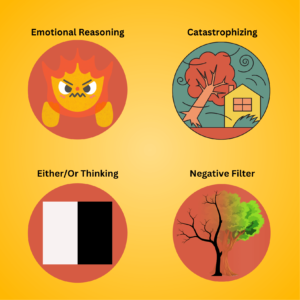
Cognitive distortions are thought patterns that distort reality. They are completely normal, but very unhelpful. And some of us experience them (or are more aware of them) more often than others.
Understanding cognitive distortions can help us identify when they are happening, giving us more control over our emotions and behaviors.
Cognitive distortions
Black and White Thinking – Our brains love to put life into simple boxes: Good vs bad; Trustworthy vs untrustworthy. In reality, rarely is a situation all good or all bad. And rarely is a person 100% trustworthy or 100% untrustworthy.
Catastrophizing – Our minds convince us that the worst possible outcome is going to happen. “I’m going to lose my job, my spouse is going to leave me, and I’m going to be homeless the rest of my life.” Catastrophizing thoughts are often at the root when we feel anxiety.
Personalization – Our minds can blame us for things we’re not at fault for. Maybe a friend is being short and we have a thought, “I must have done something. It must be me.” When in reality, maybe the friend is just having a rough day, completely unrelated to us.
Negative Filter – Our minds can hyper-focus on the negative, ignoring any positive or neutral aspects of a situation. Maybe you give a presentation, the audience loved it, your boss praised you on it, but you’re focused only on that one, very small mistake you made.
Mind Reading – Our minds convince us we know what’s going on inside someone else’s mind. Maybe we see a certain facial expression, and we think the person is negatively judging us. None of us are mind readers.
Emotional Reasoning – “I feel afraid, therefore this must be a threatening situation.” Our minds are great at fooling us into believing that our emotions are true.
Should Statements – Our thoughts can hold us to unrealistic expectations. “I shouldn’t feel angry when someone cuts me off while driving.” Maybe you shouldn’t flip the person off, but it’s completely normal to feel angry and frustrated when someone drives recklessly. Under should statements lies judgements towards ourselves.
Overgeneralizing – Our thoughts love to draw general conclusions based off very little information. “I didn’t perform well on today’s test, therefore I’m not good at taking tests.”
What can we do about our unhelpful thoughts?
IT’S NORMAL
As long as we’re human our brains will continue to produce cognitive distortions. It’s important to remind ourselves of this.
INCREASE OUR AWARENESS
It can be tempting to have a goal of eliminating distorted thoughts altogether. But, this is a setup for failure. Instead, a more realistic goal is to just become more aware of them more often.
Most of the day we’re on autopilot. We’re simply reacting to our environment and our thoughts. So, the more we can pay attention to our thoughts, the more likely we are to identify thought distortions when they happen, and the more control we have over our situation.
LABEL OUR THOUGHTS
When we notice a thought distortion, we should label it and call it what it is. By labeling our thoughts, we immediately put ourselves as an observer of thoughts rather than a participant. And when we do that, we become more objective and realistic.
CHALLENGE OUR THOUGHTS
Once we label the thought, we should challenge it.
- What evidence do I have that supports the validity of the thought?
- What evidence do I have against it?
- Is this a helpful thought?
- What would be more helpful?
- What would be a more realistic assessment of this situation?
